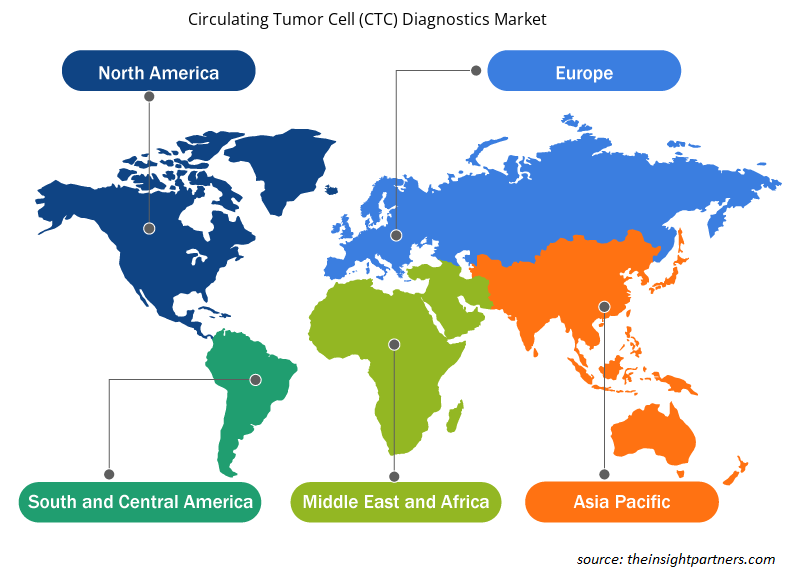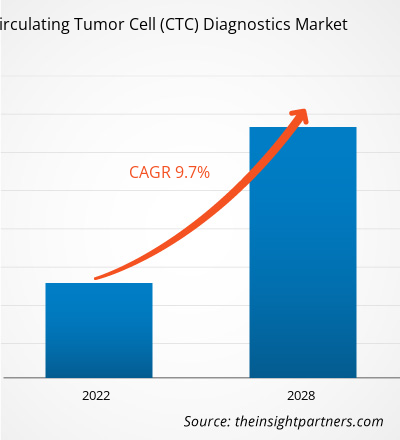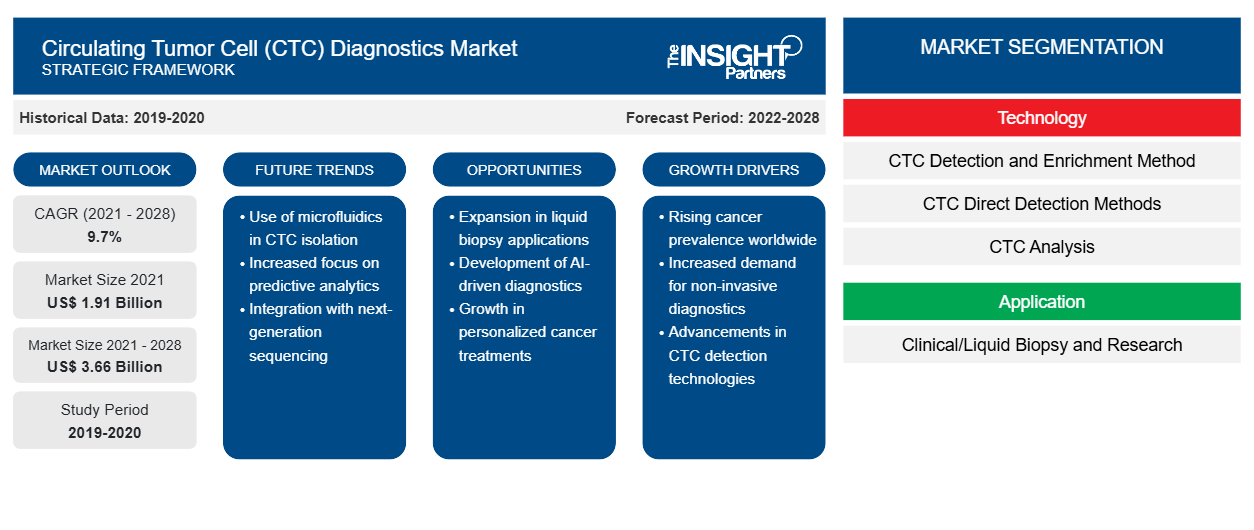Der Markt für die Diagnostik zirkulierender Tumorzellen (CTC) soll von 1.909,41 Millionen US-Dollar im Jahr 2021 auf 3.656,38 Millionen US-Dollar im Jahr 2028 anwachsen; von 2021 bis 2028 wird mit einer durchschnittlichen jährlichen Wachstumsrate von 9,7 % gerechnet.
Zirkulierende Tumorzellen (CTCs) haben ein enormes Potenzial bei der Diagnose und Behandlung von Krebs. Es wurden viele Techniken entwickelt und werden kontinuierlich verbessert, um ihre Wirksamkeit bei der Erkennung, Isolierung, Anreicherung und Analyse von CTCs zu verbessern. Der am häufigsten verwendete Ansatz zur Erkennung und Isolierung von CTCs ist die immunbasierte Erkennung, bei der Antikörper selektiv Zelloberflächenantigene binden. Tumorzellen exprimieren andere Zelloberflächenmarker als Blutzellen und werden von den zirkulierenden Zellen getrennt. CTCs helfen dabei, kleinere Untergruppen von Zellen im Primärgewebe zu erkennen, die schließlich zu einer Behandlungsresistenz oder einem Rückfall der Krankheit führen können. Daher kann die Erkennung und Charakterisierung von CTCs ein unvermeidlicher Schritt bei der Behandlung solider Tumormalignitäten sein.
Passen Sie diesen Bericht Ihren Anforderungen an
Sie erhalten kostenlos individuelle Anpassungen an jedem Bericht, einschließlich Teilen dieses Berichts oder einer Analyse auf Länderebene, eines Excel-Datenpakets sowie tolle Angebote und Rabatte für Start-ups und Universitäten.
-
Holen Sie sich die wichtigsten Markttrends aus diesem Bericht.Dieses KOSTENLOSE Beispiel umfasst eine Datenanalyse von Markttrends bis hin zu Schätzungen und Prognosen.
Der Markt für zirkulierende Tumorzellendiagnostik (CTC) ist nach Technologie, Anwendung, Endnutzer und Geografie segmentiert. Der Markt ist geografisch grob in Nordamerika, Europa, Asien-Pazifik, den Nahen Osten und Afrika sowie Süd- und Mittelamerika unterteilt. Der Bericht bietet Einblicke und eine eingehende Analyse des Marktes und betont Parameter wie Markttrends, technologische Fortschritte und Marktdynamik sowie die Analyse der Wettbewerbslandschaft der weltweit führenden Marktteilnehmer.
Markteinblicke
Steigende Nachfrage nach minimalinvasiven Diagnoseverfahren treibt das Marktwachstum im Bereich der zirkulierenden Tumorzellen (CTC)-Diagnostik im Prognosezeitraum voran
Patienten bevorzugen zunehmend minimalinvasive oder nichtinvasive Verfahren zu Diagnosezwecken. Früherkennung von Krebs, Mutationserkennung, Tumorüberwachung während der Behandlung und Rezidivüberwachung sind mithilfe der zirkulierenden Tumorzelldiagnostik möglich, einer nichtinvasiven Methode. Forscher können alle epigenetischen und genetischen Veränderungen in soliden Tumoren anhand von Blutproben mit zirkulierenden Tumorzellen verfolgen. Diese Tests sind für die Patienten weniger riskant und Ärzte können sie problemlos mehrmals durchführen. Patienten bevorzugen minimalinvasive Verfahren, da die bei solchen Verfahren verwendeten fortschrittlichen Instrumente feinere und komplexere Arbeiten mit geringerem Risiko, weniger Schmerzen und weniger Narbenbildung ermöglichen.
Aufgrund technologischer Fortschritte in Bezug auf Durchführbarkeit und Verarbeitungszeiten haben die Diagnostik zirkulierender Tumorzellen und die Flüssigbiopsie in jüngster Zeit als nichtinvasive Alternative zur Gewebebiopsie bei Krebspatienten erhebliches Interesse geweckt. Die Einführung der Flüssigbiopsie wird durch ein besseres Verständnis verbesserter minimalinvasiver Krebserkennungstechnologien gefördert. Das Marktwachstum wird durch die steigende Nachfrage nach nichtinvasiven Werkzeugen und die Akzeptanz von CTC-Tests und Flüssigbiopsien in Laboren beeinflusst. Eine Flüssigbiopsie ist eine nichtinvasive und einfache Alternative zu chirurgischen Biopsien, die es Ärzten ermöglicht, aus einer einfachen Blutprobe eine Reihe von Informationen über Tumore zu gewinnen. Bluttests sind schmerzlos, nichtinvasiv, bergen keine Risiken und reduzieren die Kosten und den Zeitaufwand für die Diagnose eines Problems. Darüber hinaus können CTCs, cfDNAs, Exosomen und Mikrovesikel in einer Blutprobe nachgewiesen werden, was blutbasierte Flüssigbiopsien beliebter macht. Somit treibt die erhöhte Nachfrage nach minimalinvasiven Diagnosetests das Marktwachstum an.
Technologieeinblicke
Basierend auf der Technologie ist der globale Markt für die Diagnostik zirkulierender Tumorzellen (CTC) in CTC-Erkennungs- und Anreicherungsmethoden, CTC-Direkterkennungsmethoden und CTC-Analyse unterteilt. Im Jahr 2020 hatte das Segment CTC-Erkennung und -Anreicherung den größten Marktanteil. Darüber hinaus wird erwartet, dass dasselbe Segment im Zeitraum 2021–2028 die höchste durchschnittliche jährliche Wachstumsrate (CAGR) auf dem Markt verzeichnet. Mithilfe der CTC-Diagnostik können Personen frühzeitig diagnostiziert werden. Daher nimmt die Einführung dieser Technologien zu, was den Markt im Prognosezeitraum voraussichtlich ankurbeln wird.
Anwendungseinblicke
Basierend auf der Anwendung ist der globale Markt für zirkulierende Tumorzellen (CTC)-Diagnostik in klinische/flüssige Biopsie und Forschung unterteilt. Im Jahr 2020 hatte das Forschungssegment einen größeren Marktanteil und es wird erwartet, dass dasselbe Segment zwischen 2021 und 2028 eine höhere CAGR auf dem Markt verzeichnet. Aufgrund der zunehmenden Erkennung und Diagnose verschiedener Erkrankungen auf der ganzen Welt wird erwartet, dass der Markt in Zukunft wachsen wird.
Einblicke für Endbenutzer
Basierend auf den Endnutzern ist der Markt für die Diagnostik zirkulierender Tumorzellen (CTC) in Krankenhäuser und Kliniken, Forschungs- und akademische Institute sowie Diagnosezentren unterteilt. Das Segment der Forschungs- und akademischen Institute hatte im Jahr 2021 den größten Marktanteil und wird im Prognosezeitraum voraussichtlich die höchste CAGR auf dem Markt verzeichnen. Die zunehmende Forschung zur Krebsdiagnose und therapeutischen Entwicklung, das wachsende Bewusstsein für die Krebsdiagnose und hohe Investitionen von Regierungen und anderen Unternehmen sind einige der entscheidenden Faktoren, die das Marktwachstum im Segment der Forschungs- und akademischen Institute unterstützen.
Produkteinführungen sowie Fusionen und Übernahmen sind bei den Akteuren auf dem globalen Markt für zirkulierende Tumorzellendiagnostik (CTC) weit verbreitete Strategien. Nachfolgend sind einige der jüngsten wichtigen Marktentwicklungen aufgeführt:
- Im Januar 2022 gab Thermo Fisher Scientific Inc. die vollständige Übernahme von PeproTech zu einem Gesamtkaufpreis in bar von ca. 1,85 Milliarden US-Dollar bekannt.
- Im Dezember 2021 gab Epic Sciences, Inc. die Einführung von DefineMBC bekannt, einem neuartigen Test für metastasierten Brustkrebs (MBC), der sowohl zellbasierte als auch zellfreie Analysen aus einer einzigen Blutentnahme umfasst.
Die COVID-19-Pandemie hatte negative Auswirkungen auf Krebspatienten und die Kapazitäten zur Krebsüberwachung. Aufgrund der Pandemie erschwerten zudem die reduzierten Ressourcen und die Verfügbarkeit von Pflege die Krebserkennung und -behandlung, was zu einer höheren Sterblichkeit und geringeren Überlebenschancen führte. Aufgrund eines durch Krebs und/oder seine Behandlung geschwächten Immunsystems sind Krebspatienten anfällig für infektiöse Krankheitserreger (z. B. Operationen und Chemotherapie). Dies hat die Befürchtung geweckt, dass COVID-19-Probleme und Sterblichkeit bei Krebspatienten häufig auftreten könnten. Somit wirkt sich die Pandemie negativ auf den Markt für zirkulierende Tumorzellen (CTC)-Diagnostik aus.
Regionale Einblicke in den Markt für zirkulierende Tumorzellen (CTC)-Diagnostik
Die regionalen Trends und Faktoren, die den Markt für zirkulierende Tumorzellen (CTC)-Diagnostik während des gesamten Prognosezeitraums beeinflussen, wurden von den Analysten von Insight Partners ausführlich erläutert. In diesem Abschnitt werden auch Marktsegmente und Geografien für zirkulierende Tumorzellen (CTC)-Diagnostik in Nordamerika, Europa, im asiatisch-pazifischen Raum, im Nahen Osten und Afrika sowie in Süd- und Mittelamerika erörtert.

- Erhalten Sie regionale Daten zum Markt für die Diagnostik von zirkulierenden Tumorzellen (CTC)
Umfang des Marktberichts zur Diagnostik zirkulierender Tumorzellen (CTC)
| Berichtsattribut | Details |
|---|---|
| Marktgröße im Jahr 2021 | 1,91 Milliarden US-Dollar |
| Marktgröße bis 2028 | 3,66 Milliarden US-Dollar |
| Globale CAGR (2021 - 2028) | 9,7 % |
| Historische Daten | 2019-2020 |
| Prognosezeitraum | 2022–2028 |
| Abgedeckte Segmente |
Nach Technologie
|
| Abgedeckte Regionen und Länder |
Nordamerika
|
| Marktführer und wichtige Unternehmensprofile |
|
Dichte der Marktteilnehmer für die Diagnostik zirkulierender Tumorzellen (CTC): Auswirkungen auf die Geschäftsdynamik
Der Markt für zirkulierende Tumorzellendiagnostik (CTC) wächst rasant, angetrieben durch die steigende Nachfrage der Endnutzer aufgrund von Faktoren wie sich entwickelnden Verbraucherpräferenzen, technologischen Fortschritten und einem größeren Bewusstsein für die Vorteile des Produkts. Mit steigender Nachfrage erweitern Unternehmen ihr Angebot, entwickeln Innovationen, um die Bedürfnisse der Verbraucher zu erfüllen, und nutzen neue Trends, was das Marktwachstum weiter ankurbelt.
Die Marktteilnehmerdichte bezieht sich auf die Verteilung der Firmen oder Unternehmen, die in einem bestimmten Markt oder einer bestimmten Branche tätig sind. Sie gibt an, wie viele Wettbewerber (Marktteilnehmer) in einem bestimmten Marktraum im Verhältnis zu seiner Größe oder seinem gesamten Marktwert präsent sind.
Die wichtigsten Unternehmen auf dem Markt für die Diagnostik zirkulierender Tumorzellen (CTC) sind:
- Thermo Fisher Scientific Inc.
- STEMCELL Technologies Inc.
- QIAGEN
- Präzisionsmedizin-Gruppe, LLC.
- Advanced Cell Diagnostics, Inc. (BIO-TECHNE CORPORATION)
Haftungsausschluss : Die oben aufgeführten Unternehmen sind nicht in einer bestimmten Reihenfolge aufgeführt.

- Überblick über die wichtigsten Akteure auf dem Markt für zirkulierende Tumorzellendiagnostik (CTC)
Marktsegmentierung für die Diagnostik zirkulierender Tumorzellen (CTC)
Der globale Markt für die Diagnostik zirkulierender Tumorzellen (CTC) ist nach Technologie, Anwendung, Endnutzer und Geografie segmentiert. In Bezug auf die Technologie ist der Markt in CTC-Erkennungs- und Anreicherungsmethoden, CTC-Direkterkennungsmethoden und CTC-Analyse unterteilt. Basierend auf der Anwendung ist der globale Markt für die Diagnostik zirkulierender Tumorzellen (CTC) in klinische/flüssige Biopsie und Forschung unterteilt. Basierend auf den Endnutzern ist der Markt für die Diagnostik zirkulierender Tumorzellen (CTC) in Krankenhäuser und Kliniken, Forschungs- und akademische Institute sowie Diagnosezentren segmentiert. Der Markt ist geografisch grob in Nordamerika, Europa, Asien-Pazifik, den Nahen Osten und Afrika sowie Süd- und Mittelamerika segmentiert.
Firmenprofile
- Thermo Fisher Scientific Inc.
- STEMCELL Technologies Inc.
- QIAGEN
- Präzisionsmedizin-Gruppe, LLC.
- Advanced Cell Diagnostics, Inc. (BIO-TECHNE CORPORATION)
- Epische Wissenschaften
- Bildschirmzelle
- Ikonisys, Inc.
- IVDiagnostik
- Fluxion Biosciences Inc0
- Historische Analyse (2 Jahre), Basisjahr, Prognose (7 Jahre) mit CAGR
- PEST- und SWOT-Analyse
- Marktgröße Wert/Volumen – Global, Regional, Land
- Branchen- und Wettbewerbslandschaft
- Excel-Datensatz
Aktuelle Berichte
Erfahrungsberichte
Grund zum Kauf
- Fundierte Entscheidungsfindung
- Marktdynamik verstehen
- Wettbewerbsanalyse
- Kundeneinblicke
- Marktprognosen
- Risikominimierung
- Strategische Planung
- Investitionsbegründung
- Identifizierung neuer Märkte
- Verbesserung von Marketingstrategien
- Steigerung der Betriebseffizienz
- Anpassung an regulatorische Trends























 Kostenlose Probe anfordern für - Markt für die Diagnostik zirkulierender Tumorzellen (CTC)
Kostenlose Probe anfordern für - Markt für die Diagnostik zirkulierender Tumorzellen (CTC)